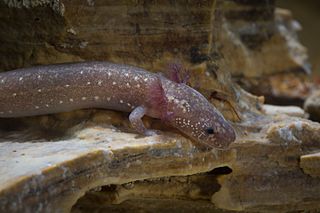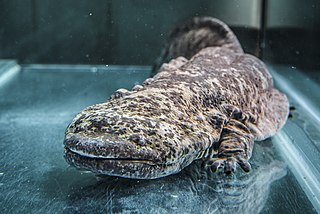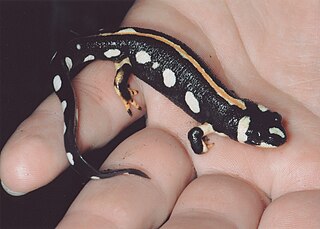
The hellbender, also known as the hellbender salamander, is a species of aquatic giant salamander endemic to the eastern and central United States. It is the largest salamander in North America. A member of the family Cryptobranchidae, the hellbender is the only extant member of the genus Cryptobranchus. Other closely related salamanders in the same family are in the genus Andrias, which contains the Japanese and Chinese giant salamanders. The hellbender, which is much larger than all other salamanders in its geographic range, employs an unusual means of respiration, and fills a particular niche—both as a predator and prey—in its ecosystem, which either it or its ancestors have occupied for around 65 million years. The species is listed as Near Threatened on the IUCN Red List of Threatened Species.

Salamanders are a group of amphibians typically characterized by their lizard-like appearance, with slender bodies, blunt snouts, short limbs projecting at right angles to the body, and the presence of a tail in both larvae and adults. All ten extant salamander families are grouped together under the order Urodela. Salamander diversity is highest in eastern North America, especially in the Appalachian Mountains; most species are found in the Holarctic realm, with some species present in the Neotropical realm.

The Barton Springs salamander is an endangered lungless salamander. It is endemic to Texas, United States. It was first found in Barton Springs in Austin, but is now also known from other localities in the nearby Travis and Hays Counties. Barton Springs is located within Zilker Park which is situated in the Edwards Aquifer in Austin, Texas. Eliza Springs, located within Barton Springs, has one of the largest populations of Barton Springs salamanders.

The sword-tail newt is a species of true salamander from the Ryukyu Archipelago in Japan. It has recently been placed on Japan's Red List of Threatened Amphibians. Sword-tail newts are poisonous, and may also be referred to as fire-bellied newts due to the orange coloration of their underside. They are not to be confused with the common Chinese and Japanese species. It is distinguished from these two species by their larger size, broader heads and smoother skin. Its coloration ranges from brown to black, occasionally with an orange dorsal stripe. Some individuals may have light spotting or speckling on their backs.

The fire belly newt or fire newt is a genus (Cynops) of newts native to Japan and China. All of the species show bright yellow or red bellies, but this feature is not unique to this genus. Their skin contains a toxin that can be harmful if ingested.

Triturus is a genus of newts comprising the crested and the marbled newts, which are found from Great Britain through most of continental Europe to westernmost Siberia, Anatolia, and the Caspian Sea region. Their English names refer to their appearance: marbled newts have a green–black colour pattern, while the males of crested newts, which are dark brown with a yellow or orange underside, develop a conspicuous jagged seam on their back and tail during their breeding phase.

Taylor's salamander, Ambystoma taylori, is a species of salamander found only in Laguna Alchichica, a high-altitude crater lake to the southwest of Perote, Mexico. It was first described in 1982 but had been known to science prior to that. It is a neotenic salamander, breeding while still in the larval state and not undergoing metamorphosis. The lake in which it lives is becoming increasingly saline and less suitable for the salamander, which is declining in numbers. The International Union for Conservation of Nature (IUCN) has rated it as being "critically endangered".

The Lake Patzcuaro salamander, locally known as achoque, Ambystoma dumerilii, is a neotenic salamander species.

The Zagros Mountains forest steppe is a temperate broadleaf and mixed forests ecoregion in Western Asia. The ecoregion extends along the Zagros Mountains, stretching from eastern Turkey and northern Iraq to southern Iran.
The Puerto Hondo stream salamander or Michoacan stream salamander, Ambystoma ordinarium, is a mole salamander from the Trans-Mexican Volcanic Belt within the Mexican state of Michoacán.

The Japanese giant salamander is a species of fully aquatic giant salamander endemic to Japan. With a length of up to 5 feet (1.5 m), it is the third-largest salamander in the world, only being surpassed by the very similar and closely related Chinese giant salamander.

The Chinese giant salamander is one of the largest salamanders and one of the largest amphibians in the world. It is fully aquatic and is endemic to rocky mountain streams and lakes in the Yangtze river basin of central China. Either it or a close relative has been introduced to Kyoto Prefecture in Japan and to Taiwan. It is considered critically endangered in the wild due to habitat loss, pollution, and overcollection, as it is considered a delicacy and used in traditional Chinese medicine. On farms in central China, it is extensively farmed and sometimes bred, although many of the salamanders on the farms are caught in the wild. It has been listed as one of the top-10 "focal species" in 2008 by the Evolutionarily Distinct and Globally Endangered project.

The striped newt is a species of aquatic salamander native to the southeastern United States. It is a close relative of the eastern newt, with which it shares territory, and can be distinguished from the latter by the presence of red stripes running down the sides of its back and red spots on its back that lack a black outline.
Neurergus crocatus, the yellow-spotted newt, Azerbaijan newt, Azerbaijan mountain newt, mountain newt, or Lake Urmia newt, is a species of salamander in the family Salamandridae. It occurs in the mountains west of Lake Urmia, in northwestern Iran, northeastern Iraq, and southeastern Turkey.

Neurergus is a genus of salamanders, more specifically newts, in the family Salamandridae. They are found in the Middle East, and are kept and bred in captivity for their bright colors. In nature, they inhabit streams and small rivers, and the surrounding forests or shrublands. All of the Neurergus are considered threatened species, primarily due to destruction of habitat and overcollection for the pet trade.

Neurergus derjugini, the Kurdistan newt, is a species of salamander in the family Salamandridae found in areas of Kurdistan. Its natural habitats are subtropical or tropical dry shrubland and rivers.

The Persian brook salamander or Persian mountain salamander is an endemic amphibian species of salamander in the family Hynobiidae found in Iran and possibly Azerbaijan.

The Junaluska salamander is a species of lungless salamander native to the south-eastern United States. It was first described by David M. Sever, Harold M. Dundee, and Charles D. Sullivan who found the species in the range from the Cheoah River, Santeetlah Creek, and Tululah Creek in Graham County of North Carolina. Adults of this species can be found near large, rocky streams and on rainy nights on roads in the areas specified. The salamander is characterized by brownish-yellow coloration with a series of small dots along the body and a robust build compared to the other salamanders in Eurycea. The Junaluska salamander's breeding habits tend to be in large streams where the eggs are laid and attached to the bottom of rocks in the streams where they are found. According to the overall conservation listing for IUCN, this species is listed as Vulnerable. Conservation acts are important in both North Carolina and Eastern Tennessee, since the population of this species in each state is so small.

A newt is a salamander in the subfamily Pleurodelinae. The terrestrial juvenile phase is called an eft. Unlike other members of the family Salamandridae, newts are semiaquatic, alternating between aquatic and terrestrial habitats. Not all aquatic salamanders are considered newts, however. More than 100 known species of newts are found in North America, Europe, North Africa and Asia. Newts metamorphose through three distinct developmental life stages: aquatic larva, terrestrial juvenile (eft), and adult. Adult newts have lizard-like bodies and return to the water every year to breed, otherwise living in humid, cover-rich land habitats.

There are 14 species of amphibians and 5 species of reptiles known to occur in Mount Rainier National Park.




















